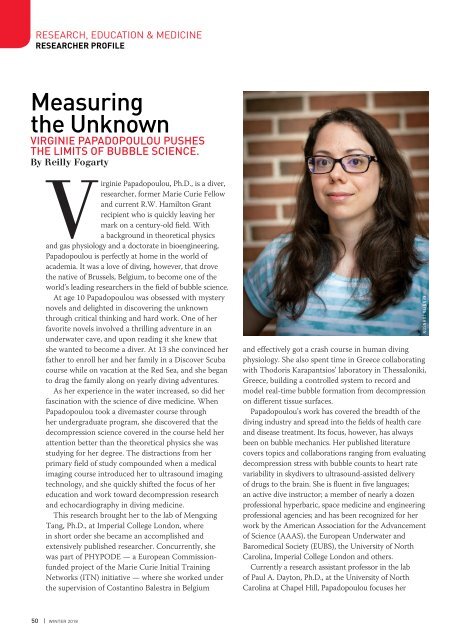AD 2018 Q1
Alert Diver is the dive industry’s leading publication. Featuring DAN’s core content of dive safety, research, education and medical information, each issue is a must-read reference, archived and shared by passionate scuba enthusiasts. In addition, Alert Diver showcases fascinating dive destinations and marine environmental topics through images from the world’s greatest underwater photographers and stories from the most experienced and eloquent dive journalists in the business.
Alert Diver is the dive industry’s leading publication. Featuring DAN’s core content of dive safety, research, education and medical information, each issue is a must-read reference, archived and shared by passionate scuba enthusiasts. In addition, Alert Diver showcases fascinating dive destinations and marine environmental topics through images from the world’s greatest underwater photographers and stories from the most experienced and eloquent dive journalists in the business.
You also want an ePaper? Increase the reach of your titles
YUMPU automatically turns print PDFs into web optimized ePapers that Google loves.
RESEARCH, EDUCATION & MEDICINE<br />
RESEARCHER PROFILE<br />
Measuring<br />
the Unknown<br />
VIRGINIE PAP<strong>AD</strong>OPOULOU PUSHES<br />
THE LIMITS OF BUBBLE SCIENCE.<br />
By Reilly Fogarty<br />
Virginie Papadopoulou, Ph.D., is a diver,<br />
researcher, former Marie Curie Fellow<br />
and current R.W. Hamilton Grant<br />
recipient who is quickly leaving her<br />
mark on a century-old field. With<br />
a background in theoretical physics<br />
and gas physiology and a doctorate in bioengineering,<br />
Papadopoulou is perfectly at home in the world of<br />
academia. It was a love of diving, however, that drove<br />
the native of Brussels, Belgium, to become one of the<br />
world’s leading researchers in the field of bubble science.<br />
At age 10 Papadopoulou was obsessed with mystery<br />
novels and delighted in discovering the unknown<br />
through critical thinking and hard work. One of her<br />
favorite novels involved a thrilling adventure in an<br />
underwater cave, and upon reading it she knew that<br />
she wanted to become a diver. At 13 she convinced her<br />
father to enroll her and her family in a Discover Scuba<br />
course while on vacation at the Red Sea, and she began<br />
to drag the family along on yearly diving adventures.<br />
As her experience in the water increased, so did her<br />
fascination with the science of dive medicine. When<br />
Papadopoulou took a divemaster course through<br />
her undergraduate program, she discovered that the<br />
decompression science covered in the course held her<br />
attention better than the theoretical physics she was<br />
studying for her degree. The distractions from her<br />
primary field of study compounded when a medical<br />
imaging course introduced her to ultrasound imaging<br />
technology, and she quickly shifted the focus of her<br />
education and work toward decompression research<br />
and echocardiography in diving medicine.<br />
This research brought her to the lab of Mengxing<br />
Tang, Ph.D., at Imperial College London, where<br />
in short order she became an accomplished and<br />
extensively published researcher. Concurrently, she<br />
was part of PHYPODE — a European Commissionfunded<br />
project of the Marie Curie Initial Training<br />
Networks (ITN) initiative — where she worked under<br />
the supervision of Costantino Balestra in Belgium<br />
and effectively got a crash course in human diving<br />
physiology. She also spent time in Greece collaborating<br />
with Thodoris Karapantsios’ laboratory in Thessaloniki,<br />
Greece, building a controlled system to record and<br />
model real-time bubble formation from decompression<br />
on different tissue surfaces.<br />
Papadopoulou’s work has covered the breadth of the<br />
diving industry and spread into the fields of health care<br />
and disease treatment. Its focus, however, has always<br />
been on bubble mechanics. Her published literature<br />
covers topics and collaborations ranging from evaluating<br />
decompression stress with bubble counts to heart rate<br />
variability in skydivers to ultrasound-assisted delivery<br />
of drugs to the brain. She is fluent in five languages;<br />
an active dive instructor; a member of nearly a dozen<br />
professional hyperbaric, space medicine and engineering<br />
professional agencies; and has been recognized for her<br />
work by the American Association for the Advancement<br />
of Science (AAAS), the European Underwater and<br />
Baromedical Society (EUBS), the University of North<br />
Carolina, Imperial College London and others.<br />
Currently a research assistant professor in the lab<br />
of Paul A. Dayton, Ph.D., at the University of North<br />
Carolina at Chapel Hill, Papadopoulou focuses her<br />
KENNITA JOHNSON<br />
50 | WINTER <strong>2018</strong>









